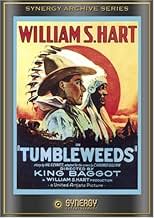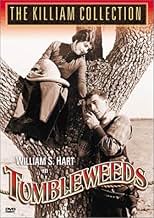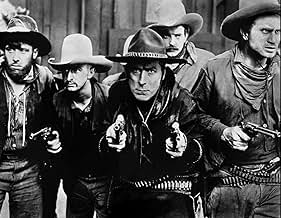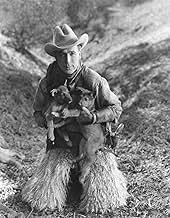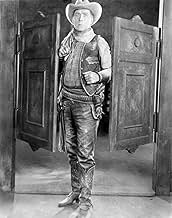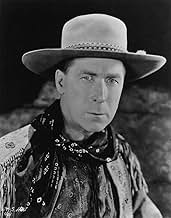CALIFICACIÓN DE IMDb
6.6/10
737
TU CALIFICACIÓN
El gobierno concederá una franja de terreno a los colonos que quieran vivir y trabajar allí. La señal de partida será un disparo que iniciará la carrera hacia los mejores campos y concesione... Leer todoEl gobierno concederá una franja de terreno a los colonos que quieran vivir y trabajar allí. La señal de partida será un disparo que iniciará la carrera hacia los mejores campos y concesiones.El gobierno concederá una franja de terreno a los colonos que quieran vivir y trabajar allí. La señal de partida será un disparo que iniciará la carrera hacia los mejores campos y concesiones.
- Dirección
- Guionistas
- Elenco
William S. Hart
- Don Carver
- (as Wm. S. Hart)
- …
Richard Neill
- Bill Freel
- (as Richard R. Niell)
George F. Marion
- Old Man
- (as George Marion)
Taylor N. Duncan
- Cavalry Major
- (as Ted Duncan)
Nora Cecil
- Pioneer Mother
- (sin créditos)
Nino Cochise
- Indian
- (sin créditos)
Monte Collins
- Hicks
- (sin créditos)
Fred Gamble
- Hotel Proprietor
- (sin créditos)
George Marion
- Homesteader
- (sin créditos)
Apache Bill Russell
- Indian
- (sin créditos)
- Dirección
- Guionistas
- Todo el elenco y el equipo
- Producción, taquilla y más en IMDbPro
Opiniones destacadas
Just from reading about him, I became a fan of William S. Hart before I ever saw one of his movies.
When I moved to Los Angeles, I made a pilgrimage to the late lamented Silent Movie Theatre on Fairfax, not only to see whatever silent films there might be available, but to plead for a chance to see any Hart film, and especially "Tumbleweeds," about which I had read so much.
Alas, the Hamptons, owners of the Theatre, never did show it, but I was able to rent a 16 mm print and show it myself, in my tiny living room.
It was all I had hoped. It was, and is, magnificent.
Character development was nigh onto perfect, and the intertitles by C. Gardner Sullivan, surely one of the greatest of such writers, merely enhanced the beauty of the presentation.
Oh, but there is more: Camera angles were brilliantly formatted. Only later did I learn that Mr. Hart himself was co-director.
William S. Hart (http://www.imdb.com/name/nm0366586/?ref_=fn_al_nm_1) was born a city slicker but, like me, I guess, he fell in love with the West and its mystique. He wanted to share that love with everyone, and for too few years presented the mythology.
You can find his spoken farewell at YouTube (https://www.youtube.com/watch?v=_BlgWP3Airs), and if you're really lucky you will find a copy of "Tumbleweeds" with that farewell used as a prologue. It still moves me to tears.
One reason I cry is that, listening to him, I think how great a talkie actor he could have been, with that voice; and I think what a loss to those of us who love Westerns generally and who love William S. Hart in particular.
"Tumbleweeds" is a classic, regardless of genre.
It is poetry on film, a magnificent motion picture.
When I moved to Los Angeles, I made a pilgrimage to the late lamented Silent Movie Theatre on Fairfax, not only to see whatever silent films there might be available, but to plead for a chance to see any Hart film, and especially "Tumbleweeds," about which I had read so much.
Alas, the Hamptons, owners of the Theatre, never did show it, but I was able to rent a 16 mm print and show it myself, in my tiny living room.
It was all I had hoped. It was, and is, magnificent.
Character development was nigh onto perfect, and the intertitles by C. Gardner Sullivan, surely one of the greatest of such writers, merely enhanced the beauty of the presentation.
Oh, but there is more: Camera angles were brilliantly formatted. Only later did I learn that Mr. Hart himself was co-director.
William S. Hart (http://www.imdb.com/name/nm0366586/?ref_=fn_al_nm_1) was born a city slicker but, like me, I guess, he fell in love with the West and its mystique. He wanted to share that love with everyone, and for too few years presented the mythology.
You can find his spoken farewell at YouTube (https://www.youtube.com/watch?v=_BlgWP3Airs), and if you're really lucky you will find a copy of "Tumbleweeds" with that farewell used as a prologue. It still moves me to tears.
One reason I cry is that, listening to him, I think how great a talkie actor he could have been, with that voice; and I think what a loss to those of us who love Westerns generally and who love William S. Hart in particular.
"Tumbleweeds" is a classic, regardless of genre.
It is poetry on film, a magnificent motion picture.
In the 1939 re-release's introduction, William S. Hart explains, "The story of 'Tumbleweeds' marks one of the greatest epochs of our American history. It tells of the opening of the Cherokee Strip in the year 1889. Twelve hundred square miles of Cherokee Indian lands, on one front, over two hundred miles long, were thrown open by our government to those seeking good earth upon which they might make their homes."
Mr. Hart (as Don Carver) and comic sidekick Lucien Littlefield (as Kentucky Rose) are two of the cattle ranchers who are put out when as the Oklahoman Cherokee Strip is "thrown open" by the government. For Hart, the silver lining comes in the form of a several decades younger sweetheart, homesteader Barbara Bedford (as Molly Lassiter); however, her nasty half-brother J. Gordon Russell (as Noll Lassiter) threatens to spoil the fun. Little brother Jack Murphy (as Bart Lassiter) and his pup have the highest profile relationship that actually works. Still, the film has Hart, and its exciting "land rush!" sequence.
The re-release (which, apart from Hart's cool Shakespearian appearance, is the inferior version, by the way) features the legendary star's farewell:
"My friends, I loved the art of making motion pictures. It is as the breath of life to me no longer a cloud of dust, but a beautiful golden haze through which appears a long phantom herd of trailing cattle. At their head, a Pinto pony with an empty saddle the boys up ahead are calling -- they're waiting for you and me to help drive this last great round-up into eternity
"Adios, amigos. God bless you all, each and every one."
******* Tumbleweeds (12/20/25) King Baggot ~ William S. Hart, Lucien Littlefield, Barbara Bedford
Mr. Hart (as Don Carver) and comic sidekick Lucien Littlefield (as Kentucky Rose) are two of the cattle ranchers who are put out when as the Oklahoman Cherokee Strip is "thrown open" by the government. For Hart, the silver lining comes in the form of a several decades younger sweetheart, homesteader Barbara Bedford (as Molly Lassiter); however, her nasty half-brother J. Gordon Russell (as Noll Lassiter) threatens to spoil the fun. Little brother Jack Murphy (as Bart Lassiter) and his pup have the highest profile relationship that actually works. Still, the film has Hart, and its exciting "land rush!" sequence.
The re-release (which, apart from Hart's cool Shakespearian appearance, is the inferior version, by the way) features the legendary star's farewell:
"My friends, I loved the art of making motion pictures. It is as the breath of life to me no longer a cloud of dust, but a beautiful golden haze through which appears a long phantom herd of trailing cattle. At their head, a Pinto pony with an empty saddle the boys up ahead are calling -- they're waiting for you and me to help drive this last great round-up into eternity
"Adios, amigos. God bless you all, each and every one."
******* Tumbleweeds (12/20/25) King Baggot ~ William S. Hart, Lucien Littlefield, Barbara Bedford
"Tumbleweeds" is a classic of the silent era. It marked the final film in the career of western movie pioneer William S. Hart.
The plot revolves around the Cherokee Land Rush of 1889 Oklahoma where a large tract of land was thrown open to the public for the taking by the American government.
Don Carver (Hart) and his pal Kentucky Rose (Lucien Littlefield) had been earning their living as "tumbleweeds", another name for drifting cowpokes. When the last roundup is completed, they decide to take part in the land rush. Carver meets up with the charming Molly Lassiter (Barbara Bedford) after having had an altercation with her half brother Noll (J. Gordon Russell). Noll teams up with Bill Freel (Richard R. Neill) to acquire a choice ranch section by any means necessary. Turns out that Carver has his sights set on the same ranch which he wants to get for Molly.
The highlight of the film is of course, the land rush sequence. It is marvelously staged by Directors King Baggot and Hart himself. A cast of thousands was employed. A remarkable piece of film making for this or any other time.
The version of the film that is usually shown these days is the 1939 re-issue which had sound effects added, as well as a moving prologue filmed especially for this version. It features Hart coming out of retirement and describing the film and then talking about his career and in effect saying goodbye to all of his fans. He had left films after "Tumbleweeds" following a dispute with the film's distributor.
Hart had always insisted on realism in his films. This had worked in his early films but in the 20s, he had to compete with the more popular films of the flamboyant Tom Mix. He had reached his 60s by this time so he wisely decided to go out on top.
Ohh...the thrill of it all!
The plot revolves around the Cherokee Land Rush of 1889 Oklahoma where a large tract of land was thrown open to the public for the taking by the American government.
Don Carver (Hart) and his pal Kentucky Rose (Lucien Littlefield) had been earning their living as "tumbleweeds", another name for drifting cowpokes. When the last roundup is completed, they decide to take part in the land rush. Carver meets up with the charming Molly Lassiter (Barbara Bedford) after having had an altercation with her half brother Noll (J. Gordon Russell). Noll teams up with Bill Freel (Richard R. Neill) to acquire a choice ranch section by any means necessary. Turns out that Carver has his sights set on the same ranch which he wants to get for Molly.
The highlight of the film is of course, the land rush sequence. It is marvelously staged by Directors King Baggot and Hart himself. A cast of thousands was employed. A remarkable piece of film making for this or any other time.
The version of the film that is usually shown these days is the 1939 re-issue which had sound effects added, as well as a moving prologue filmed especially for this version. It features Hart coming out of retirement and describing the film and then talking about his career and in effect saying goodbye to all of his fans. He had left films after "Tumbleweeds" following a dispute with the film's distributor.
Hart had always insisted on realism in his films. This had worked in his early films but in the 20s, he had to compete with the more popular films of the flamboyant Tom Mix. He had reached his 60s by this time so he wisely decided to go out on top.
Ohh...the thrill of it all!
Veteran Western film actor William S. Hart was looking for just one more chance to be in a movie. A couple (1915-1916) of the 11 years he appeared in front of the camera, theater owners voted him their biggest money-making star. His schtick was playing the prototype quiet Westerner who dressed plainly. In all of his films his characters went from mostly a bad-behaving gunslinger or ruffian to become the ultimate moralistic hero. But the public wanted flashier cowboys, such as popular Tom Mix, and more action sequences than contained in a typical character-driven Hart film.
His employer, Paramount Pictures, in 1924 elected not to renew his contract, leaving Hart unemployed at age 60. The actor wanted to ride off into the sunset for one last movie. He dug deep into his wallet and produced his final film, one that critics agree was his best one in a relatively long career, December 1925's "Tumbleweeds." Hart hired scriptwriter Hal Evarts to wrap his story around the 1893 Oklahoma land rush and King Baggot to direct.
Hart intended "Tumbleweeds" as his last hurrah with several references within the script that the Old West is gone since the Oklahoma homesteaders were replacing the cowboys he had been portraying on screen. Hart plays the foreman of a big cattle ranch. The United States government during the early 1890s had ordered all large cattle herds to leave the prairie to be replaced by the new settlers who primarily farmed. Likening himself to a tumbleweed, a plant with no roots, he witnesses other herds leaving and says, "Boys, it's the end of the West." Even women can't cox him into settling down as Hart makes the remarkable statement towards the movie's conclusion that "Women ain't reliable-cows are." Carver (Hart) says he's "headed for South America where there's millions of 'em."
Embedded within the high-budgeted $312,000 film, an immense expense in those days for one person to finance, is a specular land rush scene involving almost 1,000 extras, 300 wagons and a number of horses hired to replicate the scene. The 1931 epic "Cimarron," the Academy Awards Best Picture winner that year, copied Hart's chaotic stampede of homesteaders racing to secure the best land they could stake their claim on.
Hart was able to contract United Artists to distribute "Tumbleweeds." But the actor was disappointed, despite the rave reviews the movie was receiving, because the studio didn't place the film into the larger city venues. He sued UA for such a lack of distribution, but settled out of court in 1940. A year before that, on the heels of John Ford's 1938 "Stagecoach," which rejuvenated the Western genre, Hart was asked to provide a prologue to the re-issuance of "Tumbleweeds" with a soundtrack. The 75-year-old retired actor, now a ranch owner in Newhall, California, gave an eight-minute introduction, with his last words, "The saddle is empty, the boys up ahead are calling, they're waiting for you and me to help drive this last great round-up into eternity." Hart rode into his final sunset in June 1946 at 81 years of age at his ranch. The silent Western movie star is buried near his birthplace in Brooklyn, N. Y.'s Green-Wood Cemetery.
His employer, Paramount Pictures, in 1924 elected not to renew his contract, leaving Hart unemployed at age 60. The actor wanted to ride off into the sunset for one last movie. He dug deep into his wallet and produced his final film, one that critics agree was his best one in a relatively long career, December 1925's "Tumbleweeds." Hart hired scriptwriter Hal Evarts to wrap his story around the 1893 Oklahoma land rush and King Baggot to direct.
Hart intended "Tumbleweeds" as his last hurrah with several references within the script that the Old West is gone since the Oklahoma homesteaders were replacing the cowboys he had been portraying on screen. Hart plays the foreman of a big cattle ranch. The United States government during the early 1890s had ordered all large cattle herds to leave the prairie to be replaced by the new settlers who primarily farmed. Likening himself to a tumbleweed, a plant with no roots, he witnesses other herds leaving and says, "Boys, it's the end of the West." Even women can't cox him into settling down as Hart makes the remarkable statement towards the movie's conclusion that "Women ain't reliable-cows are." Carver (Hart) says he's "headed for South America where there's millions of 'em."
Embedded within the high-budgeted $312,000 film, an immense expense in those days for one person to finance, is a specular land rush scene involving almost 1,000 extras, 300 wagons and a number of horses hired to replicate the scene. The 1931 epic "Cimarron," the Academy Awards Best Picture winner that year, copied Hart's chaotic stampede of homesteaders racing to secure the best land they could stake their claim on.
Hart was able to contract United Artists to distribute "Tumbleweeds." But the actor was disappointed, despite the rave reviews the movie was receiving, because the studio didn't place the film into the larger city venues. He sued UA for such a lack of distribution, but settled out of court in 1940. A year before that, on the heels of John Ford's 1938 "Stagecoach," which rejuvenated the Western genre, Hart was asked to provide a prologue to the re-issuance of "Tumbleweeds" with a soundtrack. The 75-year-old retired actor, now a ranch owner in Newhall, California, gave an eight-minute introduction, with his last words, "The saddle is empty, the boys up ahead are calling, they're waiting for you and me to help drive this last great round-up into eternity." Hart rode into his final sunset in June 1946 at 81 years of age at his ranch. The silent Western movie star is buried near his birthplace in Brooklyn, N. Y.'s Green-Wood Cemetery.
TUMBLEWEEDS (United Artists, 1925), Directed by King Baggott, stars the legendary William S. Hart (1865-1946) in what proved to become his final screen appearance. Virtually unknown by today's standards, Hart was a popular leading cowboy actor dating back to 1914, whose success would be categorized as a sort of Gary Cooper or John Wayne of his day. Hart was versatile in other roles, but westerns were his specialty, with many, including Hart himself, ranking TUMBLEWEEDS as his finest of all his westerns.
Opening title: "Man and beast – both blissfully unaware that their reign is over." Set in 1889, Dan Carver (William S. Hart), a range boss of the Box K Ranch, known as "just another tumbleweed," is introduced as a sympathetic cowboy who fails to shoot a rattlesnake only because it has as much right to be around as anyone else. He also takes in a couple of orphan wolf dog puppies to find them a home after their parent dogs have been poisoned. The plot develops as the United States Government allowing ranchers to graze cattle on their payment to the Cherokee Land Strip, 12,000 square miles of undeveloped prairie land between Kansas and Oklahoma. Riding to Caldwell, Kansas (population 200), on the edge of the Cherokee Strip, Dan spreads the news to its local residents. Journeying to his destination with "Kentucky Rose" (Lucien Littlefield), they encounter Mrs. Riley (Lillian Leighton), a widow woman with three children, who takes a liking to Kentucky Rose. After intervening with Noll Lassiter (J. Gordon Russell) for abusing a boy, Bart (Jack Murphy), and his dog, he forces the brutal man to apologize to both. Dan immediately bonds with Bart who now looks up to him as a father figure. However, after accidentally roping a young girl (Barbara Bedford) in a saloon, Dan soon learns that the girl, named Molly, happens to be sister of Bart and half-sister to the villainous Noll Lassiter. Because of his interest in Molly, Dan decides to settle down and stake out a homestead claim for himself, with the possibility of having Molly become his future wife. Noll, however, unwilling to overlook Dan's defeat over him, schemes with Benton, alias Bill Freel (Richard R. Neill), to have Dan put out of the way. They arrange in having Dave accused and arrested as a "sooner," which finds him being held prisoner inside a bull pen while the bad guys so as much as commit murder so they can legally stake the claim for themselves.
Most circulating prints of TUMBLEWEEDS consist of a 1939 reissue from Astor Pictures introducing eight minutes of spoken prologue by William S. Hart himself where he talks about his "greatest picture" from his Horseshoe Ranch in Newhall, California. After listening to Hart's speaking voice, it is much regret that this once popular actor of the silent screen never starred in at least one talkie western, even possibly a sound remake to his greatest movie, TUMBLEWEEDS. Chances are had be proceeded in his career in talkies, he most definitely would have succeeded, even if later reduced to matinée cowboy star as Tim McCoy or Ken Maynard for example. However, this 1939 prologue is the one and only chance for viewers to get to hear him speak, through his wonderful tribute to both himself and the movie itself.
Home video to TUMBLEWEEDS dating back to the 1980s either from Blackhawk or a decade later from Republic Pictures also contain the Hart prologue. Rather than the orchestral score with off-screen singing to title card songs, both video/DVD editions are piano scored by William H. Perry for the Killiam collection. Clocked at 77 minutes (not counting the prologue), it seems a shame that this and THE TOLL GATE (1920) to date have become the only two Hart westerns to have limited broadcasts on public television some decades ago. Considering that TUMBLEWEEDS is hailed as Hart's best movie makes one wonder if his other silent westerns are equally as good or even better? The films of William S. Hart deserve better recognition in movie history. At least TUMBLEWEEDS is still available (on DVD) to remain one of the finer westerns to come out from the silent movie era, along with being both an introduction and rediscovery to the great quiet-type cowboy hero named William S. Hart. (***)
Opening title: "Man and beast – both blissfully unaware that their reign is over." Set in 1889, Dan Carver (William S. Hart), a range boss of the Box K Ranch, known as "just another tumbleweed," is introduced as a sympathetic cowboy who fails to shoot a rattlesnake only because it has as much right to be around as anyone else. He also takes in a couple of orphan wolf dog puppies to find them a home after their parent dogs have been poisoned. The plot develops as the United States Government allowing ranchers to graze cattle on their payment to the Cherokee Land Strip, 12,000 square miles of undeveloped prairie land between Kansas and Oklahoma. Riding to Caldwell, Kansas (population 200), on the edge of the Cherokee Strip, Dan spreads the news to its local residents. Journeying to his destination with "Kentucky Rose" (Lucien Littlefield), they encounter Mrs. Riley (Lillian Leighton), a widow woman with three children, who takes a liking to Kentucky Rose. After intervening with Noll Lassiter (J. Gordon Russell) for abusing a boy, Bart (Jack Murphy), and his dog, he forces the brutal man to apologize to both. Dan immediately bonds with Bart who now looks up to him as a father figure. However, after accidentally roping a young girl (Barbara Bedford) in a saloon, Dan soon learns that the girl, named Molly, happens to be sister of Bart and half-sister to the villainous Noll Lassiter. Because of his interest in Molly, Dan decides to settle down and stake out a homestead claim for himself, with the possibility of having Molly become his future wife. Noll, however, unwilling to overlook Dan's defeat over him, schemes with Benton, alias Bill Freel (Richard R. Neill), to have Dan put out of the way. They arrange in having Dave accused and arrested as a "sooner," which finds him being held prisoner inside a bull pen while the bad guys so as much as commit murder so they can legally stake the claim for themselves.
Most circulating prints of TUMBLEWEEDS consist of a 1939 reissue from Astor Pictures introducing eight minutes of spoken prologue by William S. Hart himself where he talks about his "greatest picture" from his Horseshoe Ranch in Newhall, California. After listening to Hart's speaking voice, it is much regret that this once popular actor of the silent screen never starred in at least one talkie western, even possibly a sound remake to his greatest movie, TUMBLEWEEDS. Chances are had be proceeded in his career in talkies, he most definitely would have succeeded, even if later reduced to matinée cowboy star as Tim McCoy or Ken Maynard for example. However, this 1939 prologue is the one and only chance for viewers to get to hear him speak, through his wonderful tribute to both himself and the movie itself.
Home video to TUMBLEWEEDS dating back to the 1980s either from Blackhawk or a decade later from Republic Pictures also contain the Hart prologue. Rather than the orchestral score with off-screen singing to title card songs, both video/DVD editions are piano scored by William H. Perry for the Killiam collection. Clocked at 77 minutes (not counting the prologue), it seems a shame that this and THE TOLL GATE (1920) to date have become the only two Hart westerns to have limited broadcasts on public television some decades ago. Considering that TUMBLEWEEDS is hailed as Hart's best movie makes one wonder if his other silent westerns are equally as good or even better? The films of William S. Hart deserve better recognition in movie history. At least TUMBLEWEEDS is still available (on DVD) to remain one of the finer westerns to come out from the silent movie era, along with being both an introduction and rediscovery to the great quiet-type cowboy hero named William S. Hart. (***)
¿Sabías que…?
- Trivia(at around 1h 7 mins) Just after the locked-up "Sooners" rush Dan Carver, who is cutting through a rail, the scene shifts to a team of horses pulling a wagon. The right "off" wheeler horse can be seen to go lame but continue running with a noticeable limp.
- Citas
Don Carver: Boys - it's the last of the West.
- Versiones alternativasThe 1939-reissued version was preceded by an eight-minute sound prologue with William S. Hart introducing the film.
- ConexionesFeatured in The Great Chase (1962)
Selecciones populares
Inicia sesión para calificar y agrega a la lista de videos para obtener recomendaciones personalizadas
Detalles
Taquilla
- Presupuesto
- USD 312,000 (estimado)
- Tiempo de ejecución
- 1h 18min(78 min)
- Mezcla de sonido
- Relación de aspecto
- 1.33 : 1
Contribuir a esta página
Sugiere una edición o agrega el contenido que falta

